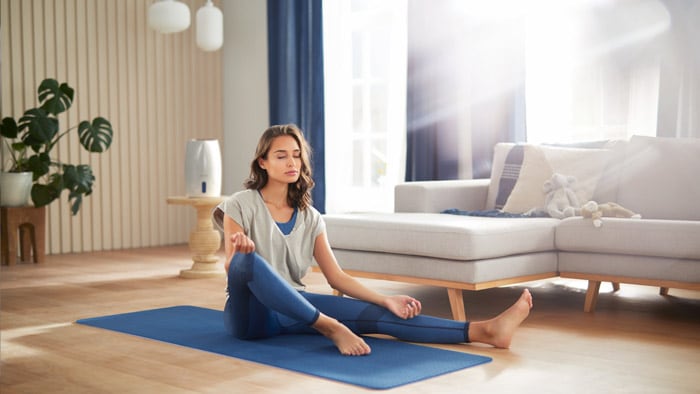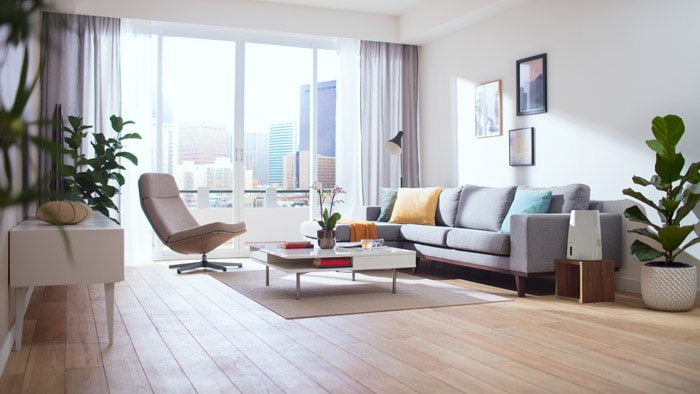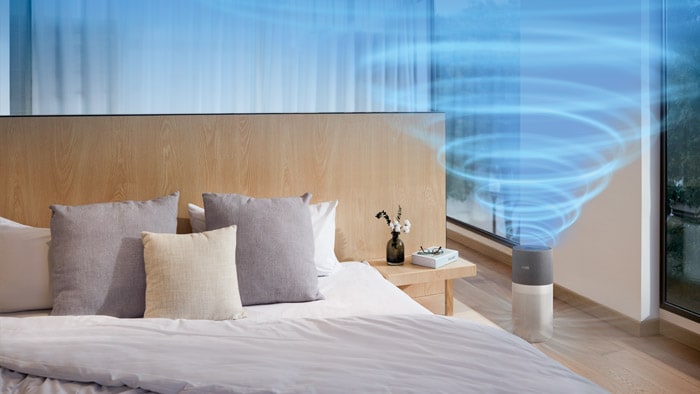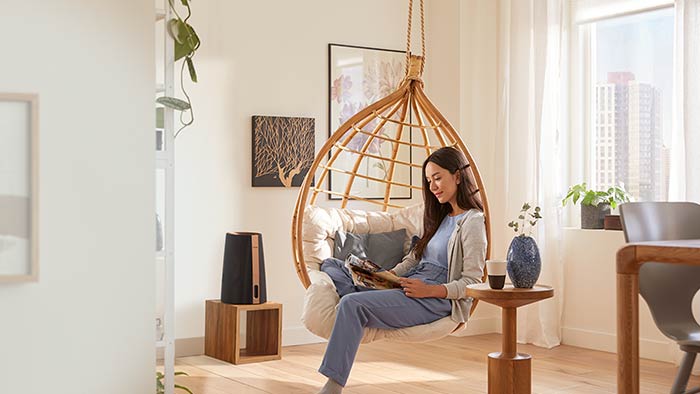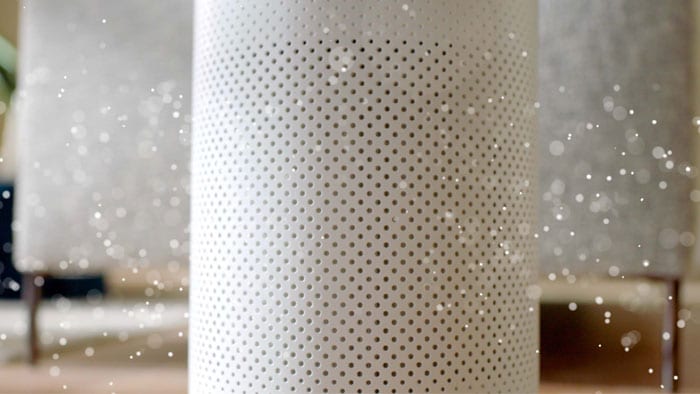Reading time: 4 Min
Breathe Easy with a Humidifier: Benefits and How it Works
In this guide we’ll look at what does a humidifier do, how to use one, and the advantages of humidifier devices.
Balancing humidity levels plays a huge role in having a healthy home with good air quality. A comfortable level is anywhere between 30% and 60%.1 If humidity rises above 70% for a prolonged period of time, issues can start, including the growth of mould, mildew, bacteria and dust mites. On the other hand, should humidity levels drop below 30%, the air becomes too dry, putting you at risk of dry skin, cracked lips, allergies, headaches, coughs and irritated eyes. The solution? Step forward the humidifier.
What is a humidifier?
To start with, let’s look at the purpose of a humidifier. What does a humidifier do? Put simply, humidifier function is all about putting moisture back into the air. When humidity levels are low the air becomes dry, which can dry out and irritate your skin and eyes. When humidity levels rise to healthy percentage, the air causes less discomfort.
When you know how to measure and monitor humidity levels and adjust accordingly, you can ensure that the perfect balance is maintained.
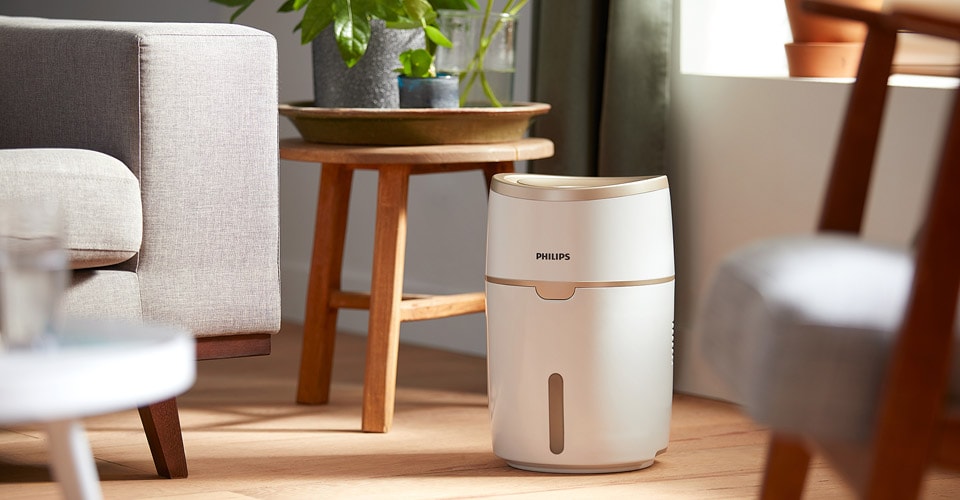
How does a humidifier work?
Essentially, a humidifier sprays water vapour into the air to increase humidity. That water comes from an evaporation process. In high quality devices like the 2-in-1 Air Purifier and Humidifier Series 3000i, this process creates a hygienic mist that quickly becomes invisible. That mist not only helps raise humidity levels, but it also makes it harder for bacteria to be carried into the air. With a 2-in-1 device like this you can use the air humidifier function and the air purification function to create a healthy atmosphere.
We know now that the purpose of a humidifier is to increase moisture levels, but how does a humidifier work? The way a humidifier functions is a simple process conceptually, but there’s a raft of expert engineering and technology behind it.
When using a humidifier, remember to follow these steps:
What you need
-
3000i Series
Air Purifier and Humidifier
AC3829/60
- Covers large rooms up to 80 m²
- 310 m³/h clean air rate (CADR)
- 600 ml/h humidification rate
- Smart control via CleanHome+ app
- Filters allergens, dust & pet dander
Benefits of Using a Humidifier
Effective air humidifier function has a number of benefits, for your home's indoor air quality and the health of people in your home. The following list of humidifier benefits provide plenty of reasons to use one: As viruses survive more easily in dry air, humid air can help prevent airborne viruses. It can also help to ease symptoms such as a dry cough. Increased humidity can work to reduce snoring as increased moisture helps soothe dry throats, which is ideal for open-mouthed sleepers. An air humidifier is a great solution for those experiencing dryness. It works to prevent dry skin and hair all year long. Humidity is a natural moisturising agent that relieves dryness, particularly in the winter when the cold weather means dryer air outside. Using a humidifier can prevent damage to your home and furniture. When the air is too dry in your home, it can cause cracks and gaps in the wooden floor and furniture. If you have wooden furniture or flooring in your home, an air humidifier is a great investment to guarantee its longevity. Increased humidity equalises electrical charges, resulting in less static electricity. A humidifier adds moisture to the air, which reduces dryness and prevents the chance of static shocks.
Improves Respiratory Health
Soothes Dry Skin and Hair
Protects Wood Furniture
Reduces Static Electricity
Choosing the Right Humidifier for Your Needs
There are different types of humidifiers available on the market. Each has its own pros and cons and suits different preferences and needs. Here is a brief introduction to the five types of humidifier: Cool mist This is the most popular type of humidifier. It adds moisture to the air in the form of cool vapour and has a cleanable filter which catches impurities in the water. It's ideal for people living in warm climates. A warm mist humidifier heats water to create vapour and then emits warm, cosy mist into your home. It is ideal for treating colds, and the heat reduces the chance of bacteria spreading. This type of humidifier is also a go-to choice for mould prevention. It can prevent mould from growing as the water is boiled before it gets released into the air. Vaporiser humidifiers come in either warm mist or cool mist designs. You can add inhalants to this affordable option, making it ideal for treating colds and illnesses. An evaporative humidifier releases a fine mist into your home. There is a fan inside the unit which blows over a wick filter. This allows the indoor air to absorb the moisture, making it more humid as a result. This type of humidifier uses high-frequency vibrations to disperse water droplets into the home. It adds moisture to the room in the form of a cool, fine mist. Think about the type of humidifier that suits your home and needs. There are five main types of humidifier available on the market, each with its own advantages and limitations. Once you've decided on the most suitable style for your requirements, you can narrow your search to find the best option for you. Humidifiers come in different shapes and sizes to accommodate different room and home sizes. If the humidifier is too small for your space, it won't be very effective. If it is too big for the room, you may face issues like condensation on windows and bacteria and mildew growth. Some humidifiers make more noise than others, and some are almost silent. If you need a humidifier for your bedroom, you should prioritise the quieter options.
Read on to learn about the various types of humidifiers and decide which may be a good fit for your family and your home.
Different Types of Humidifiers
Warm mist
Vaporiser
Evaporative
Ultrasonic
Factors to Consider When Choosing a Humidifier
There are a number of key factors to consider when choosing a new humidifier for your home. Here are some of the main things to think about when deciding on a suitable model:
Type of humidifier
Size and capacity
Noise level
From what is a humidifier to the advantages of humidifier machines, that’s everything you need to know. As you now know, using a humidifier can be a big help in creating a healthier home.


